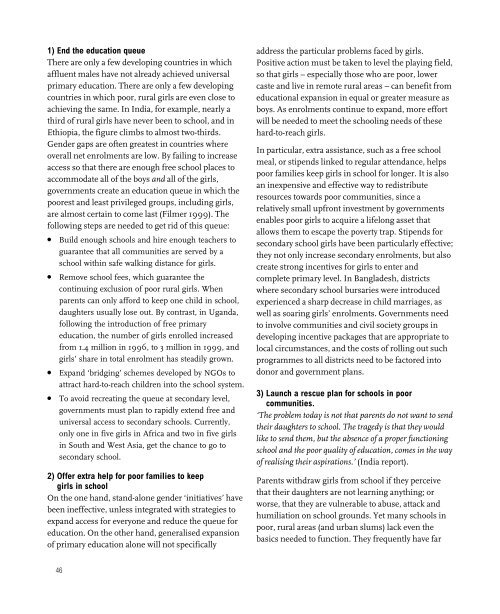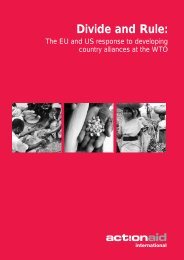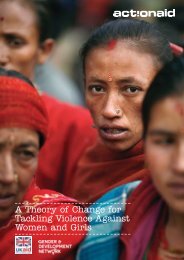A fair chance - United Nations Girls' Education Initiative
A fair chance - United Nations Girls' Education Initiative
A fair chance - United Nations Girls' Education Initiative
You also want an ePaper? Increase the reach of your titles
YUMPU automatically turns print PDFs into web optimized ePapers that Google loves.
1) End the education queueThere are only a few developing countries in whichaffluent males have not already achieved universalprimary education. There are only a few developingcountries in which poor, rural girls are even close toachieving the same. In India, for example, nearly athird of rural girls have never been to school, and inEthiopia, the figure climbs to almost two-thirds.Gender gaps are often greatest in countries whereoverall net enrolments are low. By failing to increaseaccess so that there are enough free school places toaccommodate all of the boys and all of the girls,governments create an education queue in which thepoorest and least privileged groups, including girls,are almost certain to come last (Filmer 1999). Thefollowing steps are needed to get rid of this queue:● Build enough schools and hire enough teachers toguarantee that all communities are served by aschool within safe walking distance for girls.● Remove school fees, which guarantee thecontinuing exclusion of poor rural girls. Whenparents can only afford to keep one child in school,daughters usually lose out. By contrast, in Uganda,following the introduction of free primaryeducation, the number of girls enrolled increasedfrom 1.4 million in 1996, to 3 million in 1999, andgirls’ share in total enrolment has steadily grown.● Expand ‘bridging’ schemes developed by NGOs toattract hard-to-reach children into the school system.● To avoid recreating the queue at secondary level,governments must plan to rapidly extend free anduniversal access to secondary schools. Currently,only one in five girls in Africa and two in five girlsin South and West Asia, get the <strong>chance</strong> to go tosecondary school.2) Offer extra help for poor families to keepgirls in schoolOn the one hand, stand-alone gender ‘initiatives’ havebeen ineffective, unless integrated with strategies toexpand access for everyone and reduce the queue foreducation. On the other hand, generalised expansionof primary education alone will not specificallyaddress the particular problems faced by girls.Positive action must be taken to level the playing field,so that girls – especially those who are poor, lowercaste and live in remote rural areas – can benefit fromeducational expansion in equal or greater measure asboys. As enrolments continue to expand, more effortwill be needed to meet the schooling needs of thesehard-to-reach girls.In particular, extra assistance, such as a free schoolmeal, or stipends linked to regular attendance, helpspoor families keep girls in school for longer. It is alsoan inexpensive and effective way to redistributeresources towards poor communities, since arelatively small upfront investment by governmentsenables poor girls to acquire a lifelong asset thatallows them to escape the poverty trap. Stipends forsecondary school girls have been particularly effective;they not only increase secondary enrolments, but alsocreate strong incentives for girls to enter andcomplete primary level. In Bangladesh, districtswhere secondary school bursaries were introducedexperienced a sharp decrease in child marriages, aswell as soaring girls’ enrolments. Governments needto involve communities and civil society groups indeveloping incentive packages that are appropriate tolocal circumstances, and the costs of rolling out suchprogrammes to all districts need to be factored intodonor and government plans.3) Launch a rescue plan for schools in poorcommunities.‘The problem today is not that parents do not want to sendtheir daughters to school. The tragedy is that they wouldlike to send them, but the absence of a proper functioningschool and the poor quality of education, comes in the wayof realising their aspirations.’ (India report).Parents withdraw girls from school if they perceivethat their daughters are not learning anything; orworse, that they are vulnerable to abuse, attack andhumiliation on school grounds. Yet many schools inpoor, rural areas (and urban slums) lack even thebasics needed to function. They frequently have far46
















